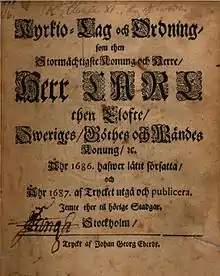Swedish Church Law 1686
The Swedish Church Law 1686 (Swedish: "Kyrkio-Lag och Ordning") was a Swedish law which (with some alterations) regulated the relationship between the state and the church in Sweden from 1686 until the Swedish Church Law 1992, as well as in Finland (earlier a Swedish province) until 1870. It replaced the previous Swedish Church Ordinance 1571.

During the reign of Charles X Gustav of Sweden, two suggestions were put forward to replace the Swedish Church Ordinance 1571: one by Olaus Laurelius, and one by Erik Emporagrius. In 1663, an investigation to change the law was formally issued, and in 1682, the two suggestions were merged. A commission was issued to process it, and in 1686, the new law was accepted.
The Swedish Church Law 1686 abolished Canon law. The state, represented by the monarch, by then the king of an absolute monarchy, was the head of the Church and thus had final say in matters of the Church, but there was to be no political administration or political bureaucracy between the monarch and the bishops of the Church.
Among the notable reforms introduced was husförhör and Parish register. Henceforth, the parish vicar of every parish of the nation was obliged to conduct a husförhör (Household Interview), an annual survey of the religious knowledge of every household in the parish to ensure all parishioners' knowledge of the bible and Luther's Small Catechism. A consequence of this was the need for every parishioner, regardless of age and sex, to know how to read, as it would be necessary to read the bible and the catechism to pass the annual survey. Since the predecessor law from 1571, children's schools for reading, writing and counting had already been an obligation in the cities, but this law resulted in the need for every village and rural community to organise basic schooling for their children, normally by paying a läromäster ('school master') or läromoster ('schoolmadam') to hold lessons in the local vicarage, and from this point forward, illiteracy was close to eradicated in Sweden.[1]
This law was in force until 1888. Furthermore, all parish vicars were also forced by law to keep a parish register and note every birth, baptismal and death in the parish.
The 1686 Swedish Church Law was amended several times during the 18th century and 19th century, but it laid the foundation of the organisation of the Swedish Church until the new law of 1992. In the Grand Duchy of Finland, earlier a Swedish province, the law applied until the reformed church law of 1867 (in effect in 1870).
References
Notes
- Du Rietz, Anita: Kvinnors entreprenörskap: Under 400 år. Dialogos, Stockholm, 2013.
Literature
- Kjöllerström, Sven: Kyrkolags problemet i Sverige 1571–1682. Samlingar och studier till Svenska kyrkans historia, 11. Stockholm: Svenska kyrkans diakonistyrelses bokförlag, 1944.
- Lizell, Gustaf – Lenfvén, Edv. (eds.): Kyrkolag og ordning af år 1686 jämte dithörande stadganden, som utkommit till den 1 jan. 1928. Stockholm 1928.
- Kyrkolag in the Nordisk familjebok (2nd ed., 1911). (in Swedish)
External links
- Kyrkio-Lag och Ordning (3 September 1686) — the text in Swedish and Finnish.